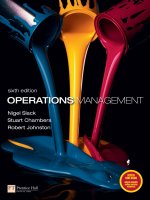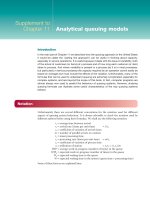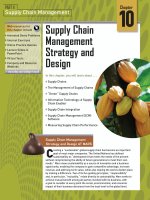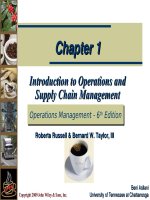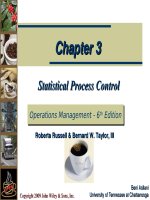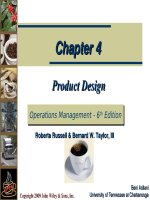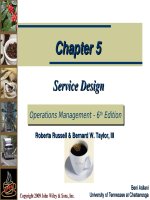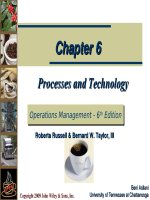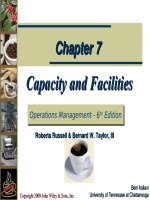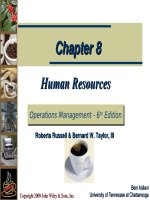Operation management 6e by russel and taylor ch13
Bạn đang xem bản rút gọn của tài liệu. Xem và tải ngay bản đầy đủ của tài liệu tại đây (1.28 MB, 45 trang )
Chapter 13
Inventory Management
Operations
Operations Management
Management -- 66thth Edition
Edition
Roberta Russell & Bernard W. Taylor, III
Copyright 2009 John Wiley & Sons, Inc.
Beni Asllani
University of Tennessee at Chattanooga
Lecture Outline
Elements of Inventory Management
Inventory Control Systems
Economic Order Quantity Models
Quantity Discounts
Reorder Point
Order Quantity for a Periodic Inventory
System
Copyright 2009 John Wiley & Sons, Inc.
13-2
What Is Inventory?
Stock of items kept to meet future
demand
Purpose of inventory management
how many units to order
when to order
Copyright 2009 John Wiley & Sons, Inc.
13-3
Inventory and Supply Chain
Management
Bullwhip effect
demand information is distorted as it moves away
from the end-use customer
higher safety stock inventories to are stored to
compensate
Seasonal or cyclical demand
Inventory provides independence from vendors
Take advantage of price discounts
Inventory provides independence between
stages and avoids work stoppages
Copyright 2009 John Wiley & Sons, Inc.
13-4
Inventory and Quality
Management in the Supply Chain
Customers usually perceive quality
service as availability of goods they want
when they want them
Inventory must be sufficient to provide
high-quality customer service in QM
Copyright 2009 John Wiley & Sons, Inc.
13-5
Types of Inventory
Raw materials
Purchased parts and supplies
Work-in-process (partially completed)
products (WIP)
Items being transported
Tools and equipment
Copyright 2009 John Wiley & Sons, Inc.
13-6
Two Forms of Demand
Dependent
Demand for items used to produce
final products
Tires stored at a Goodyear plant are
an example of a dependent demand
item
Independent
Demand for items used by external
customers
Cars, appliances, computers, and
houses are examples of independent
demand inventory
Copyright 2009 John Wiley & Sons, Inc.
13-7
Inventory Costs
Carrying cost
cost of holding an item in inventory
Ordering cost
cost of replenishing inventory
Shortage cost
temporary or permanent loss of sales
when demand cannot be met
Copyright 2009 John Wiley & Sons, Inc.
13-8
Inventory Control Systems
Continuous system (fixedorder-quantity)
constant amount ordered
when inventory declines to
predetermined level
Periodic system (fixed-timeperiod)
order placed for variable
amount after fixed passage of
time
Copyright 2009 John Wiley & Sons, Inc.
13-9
ABC Classification
Class A
5 – 15 % of units
70 – 80 % of value
Class B
30 % of units
15 % of value
Class C
50 – 60 % of units
5 – 10 % of value
Copyright 2009 John Wiley & Sons, Inc.
13-10
ABC Classification: Example
PART
1
2
3
4
5
6
7
8
9
10
UNIT COST
ANNUAL USAGE
$ 60
350
30
80
30
20
10
320
510
20
90
40
130
60
100
180
170
50
60
120
Copyright 2009 John Wiley & Sons, Inc.
13-11
ABC Classification:
Example (cont.)
PART
9
8
2
1
4
3
6
5
10
7
TOTAL
PART
VALUE
$30,600
1
16,000
2
14,000
3
5,400
4
4,800
5
3,900
3,600
6
CLASS
3,000
7
2,400
A
8
1,700
B
9
C
$85,400
10
% OF TOTAL % OF TOTAL
UNIT
ANNUAL
USAGE
VALUECOSTQUANTITY
% CUMMULATIVE
35.9
6.0
$ 60
18.7
5.0
350
16.4
4.0
30
6.3
9.0
5.680
6.0
4.630
10.0
%
OF
TOTAL
4.2
18.0
ITEMS20
VALUE
3.510
13.0
12.0
9, 8,2.8
2
71.0
320
17.0
1, 4,2.0
3
16.5
5107
6, 5, 10,
12.5
20
Copyright 2009 John Wiley & Sons, Inc.
6.0
90
11.0
A40
15.0
130
24.0
30.0
B60
100
40.0
% OF TOTAL
58.0
180QUANTITY
71.0
170
C
83.0
50 15.0
100.0
25.0
60 60.0
120
Example 10.1
13-12
Economic Order Quantity
(EOQ) Models
EOQ
optimal order quantity that will
minimize total inventory costs
Basic EOQ model
Production quantity model
Copyright 2009 John Wiley & Sons, Inc.
13-13
Assumptions of Basic
EOQ Model
Demand is known with certainty and
is constant over time
No shortages are allowed
Lead time for the receipt of orders is
constant
Order quantity is received all at once
Copyright 2009 John Wiley & Sons, Inc.
13-14
Inventory Order Cycle
Inventory Level
Order quantity, Q
Demand
rate
Average
inventory
Q
2
Reorder point, R
0
Lead
time
Order Order
placed receipt
Lead
time
Order Order
placed receipt
Copyright 2009 John Wiley & Sons, Inc.
Time
13-15
EOQ Cost Model
Co - cost of placing order
Cc - annual per-unit carrying cost
D - annual demand
Q - order quantity
Annual ordering cost =
Annual carrying cost =
Total cost =
CoD
Q
+
Co D
Q
CcQ
2
CcQ
2
Copyright 2009 John Wiley & Sons, Inc.
13-16
EOQ Cost Model
Proving equality of
costs at optimal point
Deriving Qopt
TC =
Co D
Q
CoD
+
CcQ
2
Cc
∂TC
=–
+
2
∂Q
Q
2
0=–
Qopt =
C0 D
Q2
+
Cc
Co D
Q
=
Q =
2
2
2CoD
Cc
Copyright 2009 John Wiley & Sons, Inc.
Qopt =
CcQ
2
2CoD
Cc
2CoD
Cc
13-17
EOQ Cost Model (cont.)
Annual
cost ($)
Total Cost
Slope = 0
Carrying Cost =
Minimum
total cost
Ordering Cost =
Optimal order
Qopt
Copyright 2009 John Wiley & Sons, Inc.
CcQ
2
CoD
Q
Order Quantity, Q
13-18
EOQ Example
Cc = $0.75 per gallon
Qopt =
Qopt =
Co = $150
2CoD
Cc
2(150)(10,000)
(0.75)
Qopt = 2,000 gallons
Orders per year = D/Qopt
TCmin =
TCmin =
D = 10,000 gallons
CoD
Q
+
CcQ
2
(150)(10,000) (0.75)(2,000)
+
2,000
2
TCmin = $750 + $750 = $1,500
Order cycle time = 311 days/(D/Qopt)
= 10,000/2,000
= 5 orders/year
Copyright 2009 John Wiley & Sons, Inc.
= 311/5
= 62.2 store days
13-19
Production Quantity
Model
An inventory system in which an order is
received gradually, as inventory is
simultaneously being depleted
AKA non-instantaneous receipt model
assumption that Q is received all at once is relaxed
p - daily rate at which an order is received over
time, a.k.a. production rate
d - daily rate at which inventory is demanded
Copyright 2009 John Wiley & Sons, Inc.
13-20
Production Quantity Model
(cont.)
Inventory
level
Q(1-d/p)
Maximum
inventory
level
Q
(1-d/p)
2
Average
inventory
level
0
Order
receipt period
Begin
End
order order
receipt receipt
Copyright 2009 John Wiley & Sons, Inc.
Time
13-21
Production Quantity Model
(cont.)
p = production rate
Maximum inventory level = Q -
d = demand rate
Q
d
p
=Q1-
d
p
Q
d
Average inventory level =
1p
2
Qopt =
2CoD
d
Cc 1 - p
CoD CcQ
d
TC =
+
1- p
Q
2
Copyright 2009 John Wiley & Sons, Inc.
13-22
Production Quantity Model:
Example
Cc = $0.75 per gallon
Co = $150
d = 10,000/311 = 32.2 gallons per day
2 Co D
Qopt =
Cc 1 - d
p
p = 150 gallons per day
2(150)(10,000)
=
Co D CcQ
d
TC =
+
1- p
Q
2
Production run =
D = 10,000 gallons
32.2
0.75 1 150
= 2,256.8 gallons
= $1,329
2,256.8
Q
=
= 15.05 days per order
p
150
Copyright 2009 John Wiley & Sons, Inc.
13-23
Production Quantity Model:
Example (cont.)
10,000
D
Number of production runs =
=
= 4.43 runs/year
2,256.8
Q
Maximum inventory level = Q 1 -
d
p
= 2,256.8 1 -
32.2
150
= 1,772 gallons
Copyright 2009 John Wiley & Sons, Inc.
13-24
Solution of EOQ Models with
Excel
Copyright 2009 John Wiley & Sons, Inc.
13-25
